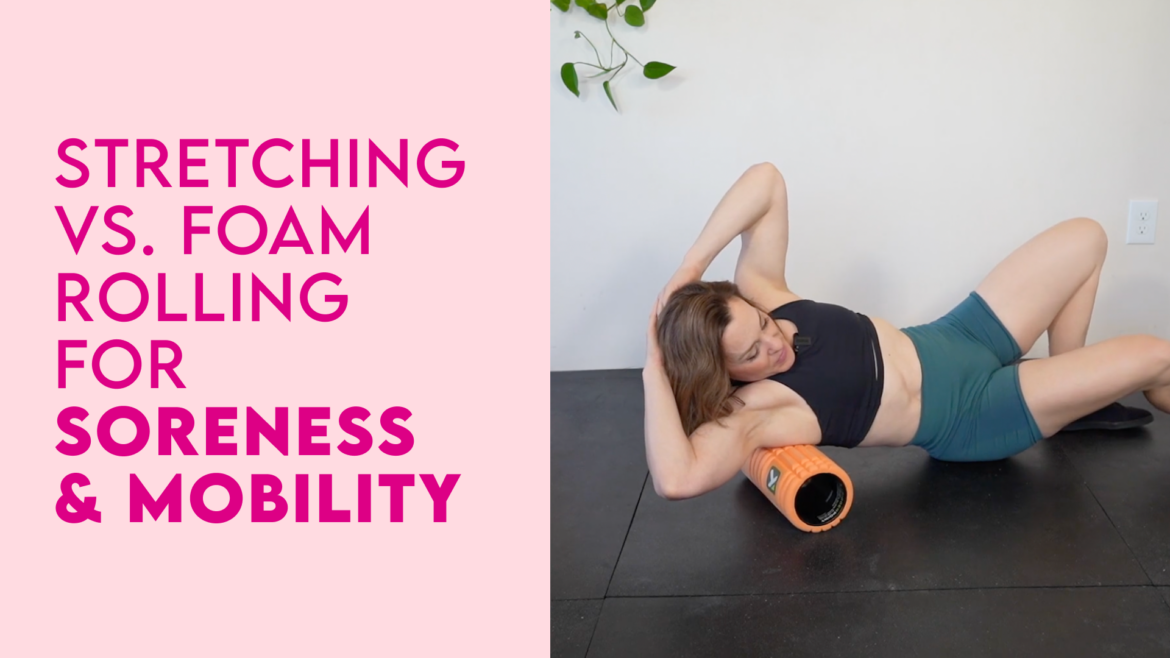Stretching and foam rolling exercises both tout serious health and fitness benefits. But to reap those benefits, it’s important to know which one to do and when – before or after a workout.
Benefits of Stretching
The primary benefit of stretching is to improve flexibility. Stretching focuses on improving range of motion, and increased flexibility can help reduce the risk of injury.
There are two types of stretching:
- Dynamic stretching involves active movements that take muscles through their entire range of motion. This gets the blood flowing and primes the body for the workout. For example, in SLAM Stretch, I may have you complete sets of bodyweight squats to prepare the body for the bigger, more intense exercises later in the workout.
- Static stretching involves extending muscles and holding the position for a period of time. This type of stretching should be used as part of a cool-down routine.
You may have noticed I don’t include stretching before SLAM workouts. This is intentional. Studies have found that stretching prior to a workout generates less muscle force. Instead, I take you through a dynamic warmup that simulates functional movements, preps the body and helps you connect with your core.
Does Stretching After A Workout Prevent Soreness?
First of all, muscles are often tight because they are weak. The human body is a master
compensator, and it finds stability where it can. While stretching can be great and bring some temporary relief, if you don’t also strengthen, the overworked muscle won’t get long term relief.
Simply put–stretching can be great for mobility and relief of immediate aches and pains, but you need to be sure you are strategically working the muscles that are causing the tightness in the first place.
Moms tend to hold a lot of tension in the hip flexors specifically. We do this for a few reasons. Our hip flexor muscles kind of check out while pregnant. And remember, a weak muscle is probably going to be a tight muscle. Your hip flexors also help you find core strength where it is missing, so it is likely that you hold tension in your hips and low back.
The Strong Like A Mother program is designed to help strengthen those mom muscles that need extra love (core, glutes, hip flexors). Try these stretches to help get the blood flowing:
Benefits of Foam Rolling
The primary benefit of foam rolling is to alleviate tension. If you only have a few minutes each day to dedicate to recovery work, this is the way to go. Foam rolling helps “release” fascial tension. (Also called myofascial release.)
Think about it this way. Your fascia is like a sausage casing. The more malleable your fascia is, the greater your muscles’ range of motion. Foam rolling is like massaging that casing so that your muscles can move with more ease.
This is an oversimplification, but in short – when we have less tension, our mobility improves, our form improves, and we get some relief from soreness, too.
Additional Benefits of Foam Rolling Include:
- Ease muscle pain and soreness
- Reduce muscle inflammation
- Increase range of motion
- Helps prevent injury
- Helps blood circulation
- Increase blood flow to muscles
- Aid in muscle recovery
- Improve balance
- Aid in relaxation
How to Foam Roll
Grab your foam roller and try these movements to relieve some tension:
Final Thoughts
Get Mom Strong offers programs for all fitness levels, from prenatal to postpartum. The app includes the SLAM Stretch program, featuring 50+ classes on stretching, mobility, myofascial release, and more.
